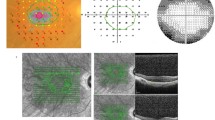Abstract
Purpose
The aim of the study was to evaluate retinal sensitivity and stereoacuity (SA) in retinitis pigmentosa (RP) patients.
Methods
Twenty-six patients with RP were examined, mean age 36.4 ± 7.21 (SD) years old and best corrected visual acuity better than 0.15 logMAR. The control group (CG) included 25 healthy subjects matching the RP group by age and sex. Every patient and healthy control underwent a complete ophthalmologic examination: Titmus, Lang, TNO stereotests and microperimetry (MP-1) (Nidek Technologies). Results were subjected to factor analysis using Varimax rotation, and p values < 0.05 were considered statistically significant.
Results
With the Titmus stereotest, the mean SA was 136.52 ± 26.5 (SD) arcsec in the RP group and 67.2 ± 11.5 (SD) in CG; Lang SA was 391.39 ± 53.72 (SD) in RP group and 1150 ± 33.4 (SD) in CG; and TNO SA was 69.3 ± 14.39 (SD) in the RP group and 15.97 ± 3.7 (SD) in CG. Factor analysis showed significant correlation between visual acuity and SA (p = 0.0001) in RP group. MP-1 demonstrated that in RP patients, inter-ocular difference in retinal sensitivity and fixation stability was related to anomalous stereopsis (p values < 0.05).
Conclusion
Progressive RP degeneration in the cone system could determine a significant impairment in the binocular vision due to anomalous inter-ocular retinal sensitivity and incomplete Panum’s area utilization, causing an incongruent retinal localization. These findings suggest a possible reason why RP patients with a central retinal involvement, even if minimal, perceive a damaged stereoscopic perception that produces a severe disability.


Similar content being viewed by others
References
Hartong DT, Berson EL, Dryja TP (2006) Retinitis pigmentosa. Lancet 368:1795–1809
Peddada KV, Brown A, Verma V, Nebbioso M (2019) Therapeutic potential of curcumin in major retinal pathologies. Int Ophthalmol 39(3):725–734
Zhang Q (2016) Retinitis pigmentosa: progress and perspective. Asia Pac J Ophthalmol 5(4):265–271
Pescosolido N, Barbato A, Pascarella A, Giannotti R, Genzano M, Nebbioso M (2014) Role of protease-inhibitors in ocular diseases. Molecules 19(12):20557–20569
Wang W, Lee SJ, Scott PA, Lu X, Emery D, Liu Y, Ezashi T, Roberts MR, Ross JW, Kaplan HJ, Dean DC (2016) Two-step reactivation of dormant cones in retinitis pigmentosa. Cell Rep 15(2):372–385
Nebbioso M, Grenga R, Karavitis P (2009) Early detection of macular changhes with multifocal ERG in patients on antimalarial drug therapy. J Ocul Pharmacol Ther 25(3):249–258
Léveillard T, Mohand-Saïd S, Lorentz O, Hicks D, Fintz AC, Clérin E, Simonutti M, Forster V, Cavusoglu N, Chalmel F, Dollé P, Poch O, Lambrou G, Sahel JA (2004) Identification and characterization of rod-derived cone viability factor. Nat Genet 36(7):755–759
Campochiaro PA, Strauss RW, Lu L, Hafiz G, Wolfson Y, Shah SM, Sophie R, Mir TA, Scholl HP (2015) Is there excess oxidative stress and damage in eyes of patients with retinitis pigmentosa? Antioxid Redox Signal 23(7):643–648
Narayan DS, Wood JP, Chidlow G, Casson RJ (2016) A review of the mechanisms of cone degeneration in retinitis pigmentosa. Acta Ophthalmol 94(8):748–754
Lupo S, Grenga PL, Vingolo EM (2011) Fourier-domain optical coherence tomography and microperimetry findings in retinitis pigmentosa. Am J Ophthalmol 151(1):106–111
Verboschi F, Domanico D, Nebbioso M, Corradetti G, Zaccaria Scalinci S, Vingolo EM (2013) New trends in visual rehabilitation with MP-1 microperimeter biofeedback: optic neural dysfunction. Funct Neurol 28(4):285–291
Hirai T, Ito Y, Arai M, Ota Y, Kojima T, Sato M, Miyake Y (2002) Loss of stereopsis with optic chiasmal lesions and stereoscopic tests as a differential test. Ophthalmology 109:1692–1702
Bridge H (2016) Effects of cortical damage on binocular depth perception. Philos Trans R Soc Lond B Biol Sci 371(1697):20150254
Alexander KR, Derlaski DH, Xie W, Fishman GA, Szlyk JP (1998) Discrimination of spatial displacements by patients with retinitis pigmentosa. Vis Res 38:1171–1181
McAnany JJ, Alexander KR, Genead MA, Fishman GA (2013) Equivalent intrinsic noise, sampling efficiency, and contrast sensitivity in patients with retinitis pigmentosa. Invest Ophthalmol Vis Sci 54(6):3857–3862
Oishi M, Nakamura H, Hangai M, Oishi A, Otani A, Yoshimura N (2012) Contrast visual acuity in patients with retinitis pigmentosa assessed by a contrast sensitivity tester. Indian J Ophthalmol 60(6):545–549
Stone JL, Barlow WE, Humayun MS, de Juan E, Milam AH (1992) Morphometric analysis of macular photoreceptors and ganglion cells in retinas with retinitis pigmentosa. Arch Ophthalmol 110:1634–1639
Cocco L, Rubbini S, Manzoli L, Billi AM, Faenza I, Peruzzi D, Matteucci A, Artico M, Gilmour RS, Rhee SG (1999) Inositides in the nucleus: presence and characterisation of the isozymes of phospholipase beta family in NIH 3T3 cells. Biochim Biophys Acta 1438(2):295–299
Tortorella P, D'Ambrosio E, Iannetti L, De Marco F, La Cava M (2015) Correlation between visual acuity, inner segment/outer segment junction, and cone outer segment tips line integrity in uveitic macular edema. Biomed Res Int 2015:853728
Seiple WH, Holopigian K, Greenstein VC, Hood DC (1993) Sites of cone system sensitivity loss in retinitis pigmentosa. Invest Ophthalmol Vis Sci 34:2638–2645
Alexander KR, Derlacki DJ, Fishman GA, Szlyk JP (1992) Grating, vernier, and letter acuity in retinitis pigmentosa. Invest Ophthalmol Vis Sci 33(12):3400–3406
Vingolo EM, Gerace E, Valente S, Spadea L, Nebbioso M (2014) Microincision vitrectomy surgery in vitreomacular traction syndrome of retinitis pigmentosa patients. Biomed Res Int 2014:537081
Nebbioso M, Barbato A, Pescosolido N (2014) Scotopic microperimetry in the early diagnosis of age-related macular degeneration: preliminary study. Biomed Res Int 2014:671529
Nebbioso M, Scarsella G, Tafani M, Pescosolido N (2013) Mechanisms of ocular neuroprotection by antioxidant molecules in animal models. J Biol Regul Homeost Agents 27(1):197–209
Author information
Authors and Affiliations
Corresponding author
Ethics declarations
Conflict of interest
The authors have no financial or proprietary interest in any materials or methods described within this manuscript.
Additional information
Publisher's Note
Springer Nature remains neutral with regard to jurisdictional claims in published maps and institutional affiliations.
Rights and permissions
About this article
Cite this article
Vingolo, E.M., Limoli, P.G., Steigerwalt, R.D. et al. Abnormal stereopsis and reduced retinal sensitivity in patients with retinitis pigmentosa. Int Ophthalmol 40, 179–184 (2020). https://doi.org/10.1007/s10792-019-01166-w
Received:
Accepted:
Published:
Issue Date:
DOI: https://doi.org/10.1007/s10792-019-01166-w




